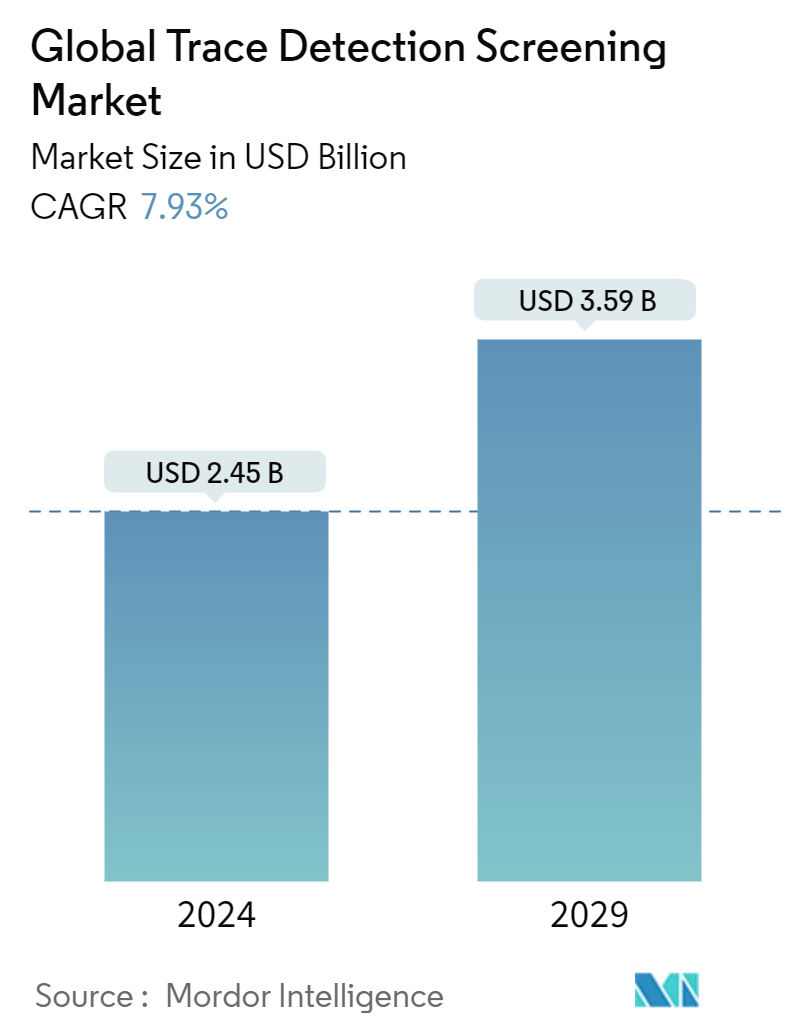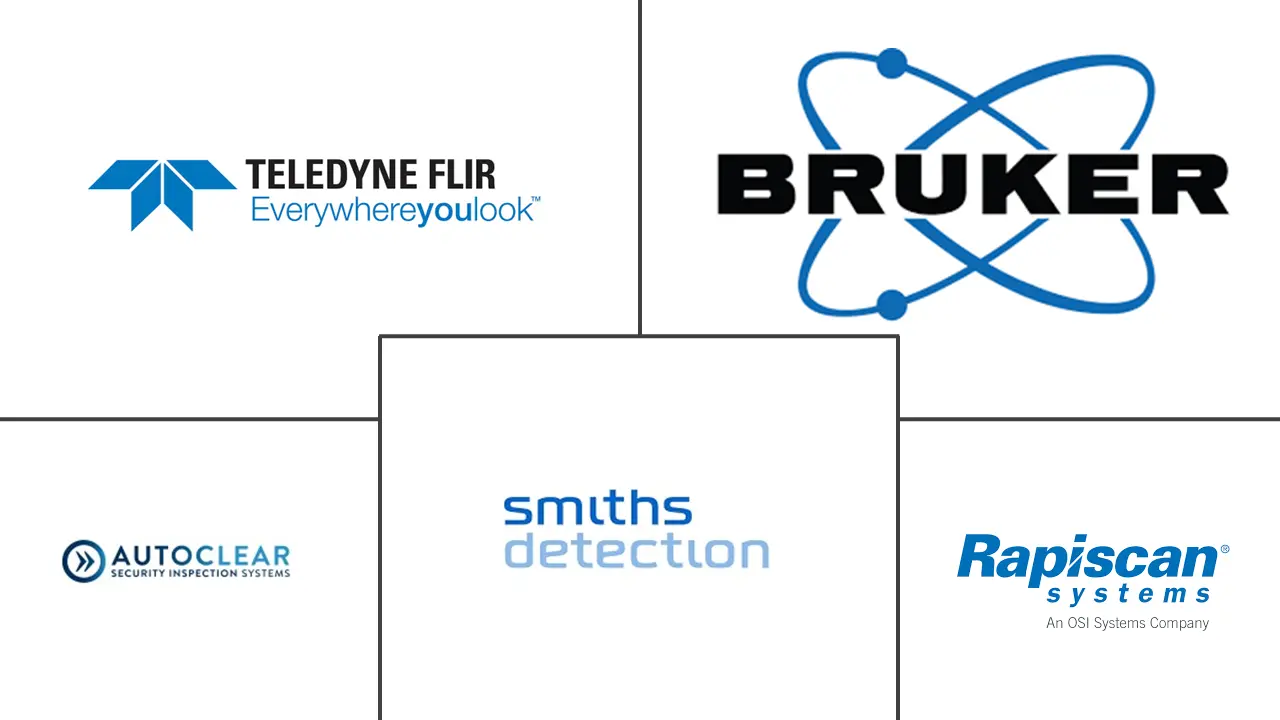Market Size of Global Trace Detection Screening Industry

| Study Period | 2022 - 2029 |
| Market Size (2024) | USD 2.45 Billion |
| Market Size (2029) | USD 3.59 Billion |
| CAGR (2024 - 2029) | 7.93 % |
| Fastest Growing Market | Asia Pacific |
| Largest Market | North America |
Major Players
*Disclaimer: Major Players sorted in no particular order |
Global Trace Detection Screening Market Analysis
The Global Trace Detection Screening Market size is estimated at USD 2.45 billion in 2024, and is expected to reach USD 3.59 billion by 2029, growing at a CAGR of 7.93% during the forecast period (2024-2029).
- Several factors, like the growing demand for aviation security, strict regulations on public safety, rising terrorist attacks & security concerns, growth in defense expenditure, and the increasing awareness about the significance of security and benefits of trace detection systems, have led to their widespread adoption.
- Advancements in trace detection technology and efficiency will likely boost the market's growth. For instance, given the diverse nature of explosive dangers that airports confront, airports must be equipped with high-quality explosive detection capabilities to ensure their security. Explosive trace detectors can effectively detect explosives by employing their physical properties. Micro sensor-based explosive trace detectors can detect dangerous explosives like Ammonium Nitrate, RDX, and Nitro-glycerine.
- The devices utilize a simple and easy method of detection. The explosive molecules are pre-concentrated on a swab or swipe. The swab is inserted into the trace detection device. The emitted molecules are absorbed from the swab, the presence of explosives is detected, and the result is processed for reporting & confirming traces of explosives. Specific technologically enhanced ETDs can further classify the explosives into several categories and detect explosives with a sensitivity of 10 nanograms. High-speed electronics and advanced signal processing algorithms help the detection result.
- In the civil security sector, explosives have been detected mainly by stationary stand-alone devices, for instance, at airport security gates. The portable devices available on the market, weighing an average of five kilograms, are suitable only for a few mobile applications. Additionally, the maintenance and cleaning of these devices are very cost-intensive. To tackle the issue, in May 2023, a team of founders from the Federal Institute for Materials Research and Testing announced that they are striving to develop a mobile explosives trace detectors market that detects explosives more reliably, making an essential contribution to security in the civil sector.
- Narcotics trace detection is gaining significant importance for various reasons. It plays a prominent role in enhancing security measures by enabling the detection and prevention of illicit drug trafficking. It helps identify and intercept narcotics at various entry points, such as airports, seaports, and border crossings, thereby mitigating the risks associated with drug smuggling. It also helps secure compliance with regulations and international agreements related to drug control. Governments and regulatory bodies often require stringent measures to prevent the trafficking of narcotics. Trace-detecting technology assists in meeting these regulatory requirements and maintaining compliance.
- Further, the market is witnessing several innovations and investments in R&D to advance trace detector technology. For instance, in July 2023, the Department of Homeland Security Science and Technology Directorate’s Next Generation Explosives Trace Detection project was announced to develop R&D solutions to provide transportation security officers and specialists across the homeland security enterprise with advanced explosives trace detection and identification capabilities.
- However, explosive trace detectors have varying sensitivity levels and may not detect trace amounts of explosives. Also, the sampling techniques can influence the detectors' effectiveness. Proper sampling and collection of trace samples are crucial for accurate results. Inadequate sampling may lead to false negatives or false positives. Moreover, failure to calibrate or maintain the equipment can affect its accuracy and reliability. These factors may restrain the growth of the market.
- Further, implementing and maintaining trace detection systems can be costly, especially for organizations with limited budgets. The high cost of acquiring and operating screening systems, conducting regular training, and employing skilled personnel can significantly restrain the market.
- Besides the direct impact on various market verticals, the global pandemic is anticipated to have a long-term effect. For instance, since the pandemic outbreak, economies of multiple countries, which feel significant, are still unable to recover as anticipated, bringing a shadow of economic recession, especially in North American and European regions. For instance, according to the International Monitory Fund (IMF) estimates, the real GDP growth of the United States is anticipated to remain in a slowdown phase till 2024 before regaining momentum again. Such trends may also slow down the market during the forecast period.
Global Trace Detection Screening Industry Segmentation
Trace detection is the detection or identification of minute or trace amounts of a substance or material. It involves collecting samples from surfaces, objects, or the environment and analyzing them, using specialized equipment or methods to detect the target substance at very low concentrations.
The global trace detection screening market is segmented by type (explosives and narcotics), product (handheld, portable/movable, and fixed), End Use (Commercial, Military and Defense, Law Enforcement, Ports and Borders, and Public Safety), and Geography (North America, Asia Pacific, Europe, Middle East and Africa, and Latin America). The market sizes and forecasts are provided in terms of value (USD) for all the above segments.
| By Type | |
| Explosive | |
| Narcotics |
| By Product | |
| Handheld | |
| Portable/Movable | |
| Fixed |
| By End-user Industry | |
| Commercial | |
| Military and Defense | |
| Law Enforcement | |
| Ports and Borders | |
| Public Safety | |
| Other End-user Industries |
| By Geography | |
| North America | |
| Europe | |
| Asia | |
| Australia and New Zealand | |
| Middle East and Africa | |
| Latin America |
Global Trace Detection Screening Market Size Summary
The global trace detection screening market is poised for significant growth, driven by increasing demands for enhanced security measures across various sectors. The market is experiencing a surge in adoption due to heightened concerns over aviation security, stringent public safety regulations, and the rising threat of terrorism. The advancement of trace detection technologies, such as micro sensor-based explosive detectors, is further propelling market expansion. These technologies are crucial for identifying explosives and narcotics at critical points like airports and border crossings, thereby ensuring compliance with international security standards. The market is characterized by innovations and investments in research and development, aimed at improving the efficiency and reliability of detection systems.
Despite the promising growth trajectory, the market faces challenges, including the high costs associated with implementing and maintaining trace detection systems. These costs can be a barrier for organizations with limited budgets, potentially restraining market growth. Additionally, the effectiveness of detection systems can be influenced by factors such as sampling techniques and equipment maintenance. The market is semi-consolidated, with key players like Smiths Detection Group, Leidos, and Bruker Corporation leading the way in product innovation and strategic collaborations. The ongoing developments and partnerships in the industry underscore the critical role of trace detection technology in enhancing security measures globally.
Global Trace Detection Screening Market Size - Table of Contents
-
1. MARKET INSIGHTS
-
1.1 Market Overview
-
1.2 Technology Snapshot
-
1.3 Industry Value Chain Analysis
-
1.4 Industry Attractiveness - Porter's Five Forces Analysis
-
1.4.1 Threat of New Entrants
-
1.4.2 Bargaining Power of Consumers
-
1.4.3 Bargaining Power of Suppliers
-
1.4.4 Threat of Substitute Products
-
1.4.5 Intensity of Competitive Rivalry
-
-
1.5 Impact of COVID-19 Aftereffects and Other Macroeconomic Factors on the Market
-
-
2. MARKET SEGMENTATION
-
2.1 By Type
-
2.1.1 Explosive
-
2.1.2 Narcotics
-
-
2.2 By Product
-
2.2.1 Handheld
-
2.2.2 Portable/Movable
-
2.2.3 Fixed
-
-
2.3 By End-user Industry
-
2.3.1 Commercial
-
2.3.2 Military and Defense
-
2.3.3 Law Enforcement
-
2.3.4 Ports and Borders
-
2.3.5 Public Safety
-
2.3.6 Other End-user Industries
-
-
2.4 By Geography
-
2.4.1 North America
-
2.4.2 Europe
-
2.4.3 Asia
-
2.4.4 Australia and New Zealand
-
2.4.5 Middle East and Africa
-
2.4.6 Latin America
-
-
Global Trace Detection Screening Market Size FAQs
How big is the Global Trace Detection Screening Market?
The Global Trace Detection Screening Market size is expected to reach USD 2.45 billion in 2024 and grow at a CAGR of 7.93% to reach USD 3.59 billion by 2029.
What is the current Global Trace Detection Screening Market size?
In 2024, the Global Trace Detection Screening Market size is expected to reach USD 2.45 billion.

